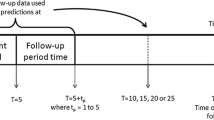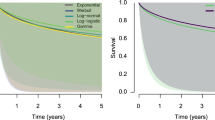Summary
Clinical studies usually employ Cox step-wise regression for multivariate investigations of prognostic factors. However, commercial packages now allow the consideration of accelerated failure time models (exponential, Weibull, log logistic, and log normal), if the underlying Cox assumption of proportional hazards is inappropriate. All-subset regressions are feasible for all these models.
We studied a group of 378 node positive primary breast cancer patients accrued at the Henrietta Banting Breast Centre of Women's College Hospital, University of Toronto, between January 1, 1977, and December 31, 1986. 85% of these patients had complete prognostic factor data for multivariate analysis, and 96% of the patients were followed to 1990. There was evidence of marked departures from the proportional hazards assumption with two prognostic factors, number of positive nodes and adjuvant systemic therapy. The data strongly supported the log normal model. The all-subset regressions indicated that three models were similarly good. The variables 1) number of positive nodes, 2) tumour size, and 3) adjuvant systemic therapy were included in all three models along with one of three biochemical receptor variables 1) ER, 2) combined receptor (ER- PgR-; ER+ PgR-; ER- PgR+; ER+ PgR+; or 3) PgR.
Better multivariate modeling was achieved by using quantitative prognostic factors, a check for appropriate underlying model-type, and all-subset variable selection. All-subset regressions should be considered for routine use with the many new prognostic factors currently under evaluation; it is very possible that there may not be a single model that is substantially better than others with the same number of variables.
Similar content being viewed by others
References
Lawless JF, Singhal K: ISMOD: an all-subsets regression program for generalized linear models. I. Statistical and computational background. Computer Methods and Programs in Biomedicine 24:117–124, 1987.
Lawless JF, Singhal K: ISMOD: an all-subsets regression program for generalized linear models. II. Program guide and examples. Computer Methods and Programs in Biomedicine 24:125–134, 1987.
Kalbfleisch JD, Prentice RL: The Statistical Analysis of Failure Time Data. John Wiley and Sons, New York, 1980.
Lawless JF: Statistical Models and Methods for Lifetime Data. John Wiley and Sons, New York, 1982.
Harris JR, Henderson IC: Natural history and staging of breast cancer. Harris JR, Hellman S, Henderson IC Kinne DW (eds) Breast Diseases. JB Lippincott, Philadelphia, 1987, pp 233–258.
Mobbs BG: Close correlation between progesterone receptor concentration and hormonal sensitivity in DMBA-induced mammary tumours of the rat. Eur J Cancer Clin Oncol 19:835–842, 1983.
Meakin JW, Hayward JL, Stewart HJ: Assessment of response and recurrence in breast cancer. Semin Oncol 5:445–449, 1978.
Clark GM, McGuire WL: Steroid receptors and other prognostic factors in primary breast cancer. Semin Oncol 15(Suppl 1):20–25, 1988.
Fisher B, Redmond CK, Wickerham DL, Rockette HE, Brown A: Relation of estrogen and/or progesterone receptor content of breast cancer to patient outcome following adjuvant chemotherapy. Breast Cancer Res Treat 3:355–364, 1983.
Saez S, Cheix F, Asselain B: Prognostic value of estrogen and progesterone receptors in primary breast cancer. Breast Cancer Res Treat 3:345–354, 1983.
Author information
Authors and Affiliations
Rights and permissions
About this article
Cite this article
Chapman, JA.W., Trudeau, M.E., Pritchard, K.I. et al. A comparison of all-subset Cox and accelerated failure time models with Cox step-wise regression for node-positive breast cancer. Breast Cancer Res Tr 22, 263–272 (1992). https://doi.org/10.1007/BF01840839
Issue Date:
DOI: https://doi.org/10.1007/BF01840839




